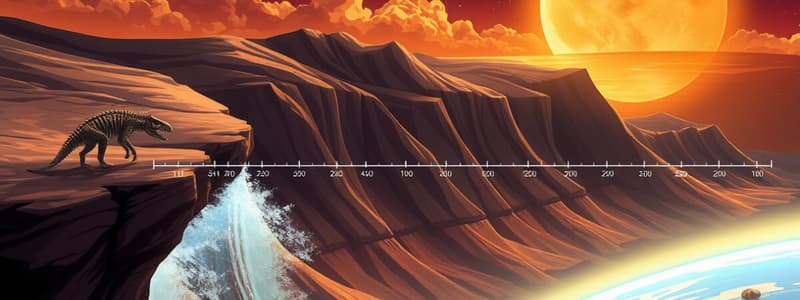Podcast
Questions and Answers
What is the geologic time scale?
What is the geologic time scale?
- A timeline marking global temperature changes
- A measurement used to chart the ages of fossils
- The duration of a single geological event
- The measurement to describe the timing and relationship of the events that have occurred throughout Earth's history (correct)
What are fossils?
What are fossils?
Preserved remains of plants or animals found in rocks.
What is an index fossil?
What is an index fossil?
A fossil known to have lived in a particular geologic age that can be used to date the rock layer in which it is found.
How old is the Earth?
How old is the Earth?
What does the Law of Superposition state?
What does the Law of Superposition state?
What is an eon?
What is an eon?
What is the Precambrian?
What is the Precambrian?
What is the Paleozoic Era?
What is the Paleozoic Era?
What is the Mesozoic Era known for?
What is the Mesozoic Era known for?
What marks the beginning of the Cenozoic Era?
What marks the beginning of the Cenozoic Era?
What is absolute dating?
What is absolute dating?
What is relative dating?
What is relative dating?
What is the fossil record?
What is the fossil record?
What are rock strata?
What are rock strata?
Study Notes
Geologic Time Scale
- A framework used to describe Earth's history in terms of timing and relationships of geological events.
- Divided into eons, eras, periods, and epochs to help organize significant changes in Earth's formation and life.
Fossils
- Preserved remains or impressions of plants and animals found in sedimentary rocks.
- Provides crucial evidence of past life forms and their environments.
Index Fossil
- Fossils that are used to identify and date the rock layers in which they are found.
- Typically from organisms that existed during a specific time period, facilitating relative dating of geological strata.
Age of the Earth
- Approximately 4.6 billion years old, indicating the duration of Earth's existence.
Law of Superposition
- Geological principle stating that in undisturbed rock layers, the oldest layers are at the bottom, and the youngest are at the top.
- Essential for understanding the chronological sequence of geological events.
Eon
- The largest subdivision of the geologic time scale, encompassing significant periods in Earth's history.
Precambrian Era
- Accounts for about 88% of Earth's history, characterized predominantly by the presence of unicellular organisms.
- Represents a vast time before multicellular life evolved.
Paleozoic Era
- Spanning from 570 to 245 million years ago, this era saw the dominance of invertebrates, fishes, amphibians, reptiles, ferns, and cone-bearing trees.
- Marked significant evolutionary advancements in life forms.
Mesozoic Era
- Known as the "Age of Reptiles," lasting from 245 to 144 million years ago.
- Featured the rise of mammals and dinosaurs, the emergence of birds, and significant plant diversity, including flowering plants.
- Culminated in the extinction event that wiped out the dinosaurs.
Cenozoic Era
- Began around 66 million years ago, referred to as the "Age of Mammals."
- Characterized by the diversification of mammals, birds, and flowering plants following the Mesozoic extinction.
Absolute Dating
- A scientific method used to determine the precise age of a fossil or rock layer, providing numerical dates.
Relative Dating
- A technique to estimate the age of a fossil based on its position relative to other fossils and rock layers.
- Lacks precise date but helps to determine the sequence of geological events.
Fossil Record
- A historical timeline formed by mineralized remains of organisms alongside their respective rock layers.
- Illuminates the evolution of life forms, their distribution, and structure over geological time.
Rock Strata
- Layers of sedimentary rock that are deposited over time, preserving the history of geological events.
- Each stratum provides insights into the environmental conditions of the Earth's past.
Studying That Suits You
Use AI to generate personalized quizzes and flashcards to suit your learning preferences.
Description
Explore the key concepts of Earth's geologic history through this flashcard quiz. Learn about important terminology such as the geologic time scale, fossils, and index fossils. Perfect for students studying Earth sciences or geology.



